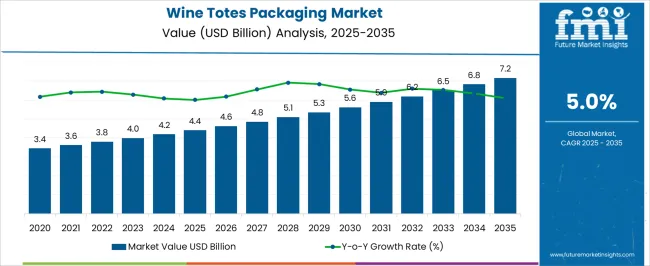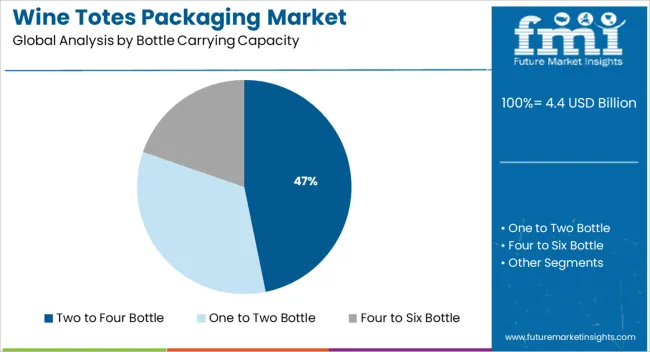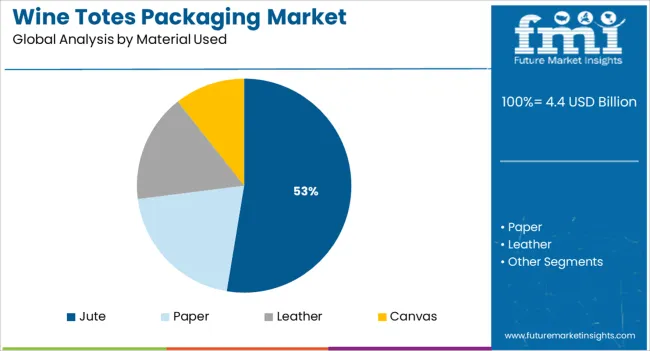The Wine Totes Packaging Market is estimated to be valued at USD 4.4 billion in 2025 and is projected to reach USD 7.2 billion by 2035, registering a compound annual growth rate (CAGR) of 5.0% over the forecast period.

| Metric | Value |
|---|---|
| Wine Totes Packaging Market Estimated Value in (2025 E) | USD 4.4 billion |
| Wine Totes Packaging Market Forecast Value in (2035 F) | USD 7.2 billion |
| Forecast CAGR (2025 to 2035) | 5.0% |
The Wine Totes Packaging market is expanding steadily, driven by the growing trend of wine gifting, evolving consumer lifestyles, and increasing demand for reusable and sustainable packaging solutions. As global wine consumption continues to rise, particularly in urban and metropolitan regions, the need for functional yet visually appealing transport and presentation methods has gained momentum. Wine totes are no longer viewed as mere carriers but as value-added packaging extensions that reflect branding, quality, and sustainability.
Innovations in lightweight materials, aesthetic finishes, and ergonomic design have contributed to the rising adoption across retail, gifting, and hospitality sectors. Increasing environmental awareness and government regulations on single-use plastics have encouraged a transition towards biodegradable and reusable tote options, positioning the market for long-term growth.
The expansion of premium and artisanal wine offerings through direct-to-consumer channels and specialty stores is further enhancing the relevance of customized wine totes as a key packaging component Continued innovation and demand for elevated consumer experiences are expected to sustain growth over the coming years.
The market is segmented by Bottle Carrying Capacity and Material Used and region. By Bottle Carrying Capacity, the market is divided into Two to Four Bottle, One to Two Bottle, and Four to Six Bottle. In terms of Material Used, the market is classified into Jute, Paper, Leather, and Canvas. Regionally, the market is classified into North America, Latin America, Western Europe, Eastern Europe, Balkan & Baltic Countries, Russia & Belarus, Central Asia, East Asia, South Asia & Pacific, and the Middle East & Africa.

The two to four bottle carrying capacity segment is projected to account for 46.8% of the wine totes packaging market revenue share in 2025, positioning it as the most widely adopted configuration. This segment’s dominance is being shaped by its practical design which balances capacity and portability for both individual consumers and retail purposes. It has been widely preferred in wine retail, gifting, and event-based consumption due to its ability to safely accommodate multiple bottles while remaining lightweight and easy to handle.
The increasing popularity of multi-bottle purchases during festive seasons, weddings, and corporate gifting events has further reinforced its utility. Manufacturers have increasingly focused on ergonomic features, reinforced handles, and cushioning dividers in this segment to enhance usability and product protection.
The segment has also benefited from compatibility with sustainable materials and customization options which align with branding strategies As consumer habits shift toward value packs and wine bundles, the two to four bottle tote is expected to remain central to consumer and distributor packaging strategies.

The jute material segment is expected to hold 52.6% of the revenue share in the wine totes packaging market in 2025, making it the most dominant material choice. This leadership is being driven by its biodegradable nature, durability, and rising acceptance as an eco-conscious alternative to synthetic fabrics. The increasing focus on sustainability in the wine and spirits industry has led brands and consumers to favor natural fiber-based materials such as jute, which align with environmental goals and regulatory trends.
Jute totes offer superior breathability, high tensile strength, and rustic visual appeal which have made them especially suitable for premium packaging and gift presentation. Additionally, jute's compatibility with printing and embossing techniques has supported its adoption in brand merchandising and promotional campaigns.
Its reusability and recyclability have enhanced its value proposition among environmentally aware consumers and retailers As market emphasis on green packaging intensifies, jute is expected to remain the preferred material for upscale and sustainable wine tote packaging solutions.
Packaging plays a vital role in improving the marketability of a product by increasing the visibility of the company’s logo or the brand name of the product.
As more than 80% of the consumers remember a company’s name through the promotional items, they are considered as better form of advertising as compared to newspaper, smart TV, online advertisement or any other forms of advertisements.
Wine totes are one such means to increase the aesthetic value of the product and improve the reputation of the company’s brand. Wine totes have an advantage over wine boxes by being sturdy and easy in handling and carrying purposes. Wine totes provide convenience for the customer to carry wine bottles to a party or a gathering.
Wine totes are tamper proof and made of multilayered film for insulating or protecting the wine bottle from getting damaged by absorbing the shocks. Wine totes are of different materials such as jute, leather, plastic, paper, etc.
Wine totes can be of different sizes catering to different amount of bottles designed as per customer requirements. Companies in North America spend close to USD 20 Million annually on printing brand specific communication on accessories that are given free with wine bottles
The need of innovative form of advertisement especially in product categories targeted to the luxury packaging market drives the demand for the wine totes packaging market. Wine totes have the ability to create a perception in consumers mind about the quality of the wine hence making it a significant form of packaging.
On the backdrop of convenience offered by the wine totes to its users the wine totes, packaging market is expected to show expansion. Features like protection of fragile bottles from shocks and ability to provide sufficient surface area for promotion and advertisement is another factor increasing the manufacturer preference for the wine totes packaging.
The regular consumption of wine in regions such as North & South America, Europe and some parts of Asia is expected to fuel the wine totes packaging market. Increasing consumer preference for a sustainable form of packaging is another factor propelling the demand for the wine totes packaging market.
However, wine totes have limited area of application as they can be used for carrying bottles only due to the cylindrical shape. The growing trend of consuming wine with meals at restaurant and at home is expected to create significant opportunity in the wine totes packaging market over the forecast period.
North & Latin America, Eastern & Western Europe are expected lead the wine totes packaging market over the forecast period owing to the regular consumption of wine in the regions.
Wine consumption in countries of APEJ region such as China, Korea, Singapore, and Thailand is significant and is expected to accounts for a considerable portion of the wine totes packaging market over the forecast period. Whereas growth for wine totes packaging market in Japan and MEA region is expected to move at a steady rate.
Some key players of wine totes packaging market are Ampac Holdings, LLC., Guangzhou Colorful Nonwoven Products Co Ltd, Wenzhou Guohong Packaging Co., Ltd, Shenzhen Beone Handbags Manufacturing Co., Ltd., Gogo Bags., Smartbags Ltd., Param Jute Products, Evans Manufacturing, Inc, Everwin Cottons Karur Private Limited, Picnic Time, Inc., Flymaxexim., etc.
The research report presents a comprehensive assessment of the market and contains thoughtful insights, facts, historical data, and statistically supported and industry-validated market data. It also contains projections using a suitable set of assumptions and methodologies.
The research report provides analysis and information according to categories such as market segments, geographies, types, technology and applications.
The report is a compilation of first-hand information, qualitative and quantitative assessment by industry analysts, inputs from industry experts and industry participants across the value chain.
The report provides in-depth analysis of parent market trends, macro-economic indicators and governing factors along with market attractiveness as per segments. The report also maps the qualitative impact of various market factors on market segments and geographies.
Wine totes packaging market can be segmented by bottle carrying capacity and by the type of material used.
The global wine totes packaging market is estimated to be valued at USD 4.4 billion in 2025.
The market size for the wine totes packaging market is projected to reach USD 7.2 billion by 2035.
The wine totes packaging market is expected to grow at a 5.0% CAGR between 2025 and 2035.
The key product types in wine totes packaging market are two to four bottle, one to two bottle and four to six bottle.
In terms of material used, jute segment to command 52.6% share in the wine totes packaging market in 2025.






Full Research Suite comprises of:
Market outlook & trends analysis
Interviews & case studies
Strategic recommendations
Vendor profiles & capabilities analysis
5-year forecasts
8 regions and 60+ country-level data splits
Market segment data splits
12 months of continuous data updates
DELIVERED AS:
PDF EXCEL ONLINE
Wine Bag Market Forecast and Outlook 2025 to 2035
Wine Cork Market Size and Share Forecast Outlook 2025 to 2035
Wine Barrel Market Size and Share Forecast Outlook 2025 to 2035
Wine Cellar Market Size and Share Forecast Outlook 2025 to 2035
Wine Enzymes Market Analysis Size Share and Forecast Outlook 2025 to 2035
Wine Box Market Size and Share Forecast Outlook 2025 to 2035
Wine Fining Agent Market Size and Share Forecast Outlook 2025 to 2035
Wine, Scotch, and Whiskey Barrels Market Size and Share Forecast Outlook 2025 to 2035
Wine Fermentation Equipment Market Size and Share Forecast Outlook 2025 to 2035
Wine Processing Equipment Market Size and Share Forecast Outlook 2025 to 2035
Wine Racks Market Size and Share Forecast Outlook 2025 to 2035
Wine Filling Machine Market Size and Share Forecast Outlook 2025 to 2035
Wine Bottle Sterilizer Market Size and Share Forecast Outlook 2025 to 2035
Wine Extract Market Size and Share Forecast Outlook 2025 to 2035
Wine Market Analysis - Size, Share, and Forecast Outlook 2025 to 2035
Wine Tourism Market Analysis - Size, Share, and Forecast Outlook 2025 to 2035
Wine Destemmer Market - Growth & Demand 2025 to 2035
Wine Filtering Machine Market Expansion - Filtration & Winemaking Technology 2025 to 2035
Wine Crusher Market Growth - Winemaking Equipment & Industry Trends 2025 to 2035
Wine Subscription Market Analysis by Subscription Model, Wine Type, Price Tier, and Subscription Frequency and Region through 2035

Thank you!
You will receive an email from our Business Development Manager. Please be sure to check your SPAM/JUNK folder too.
Chat With
MaRIA